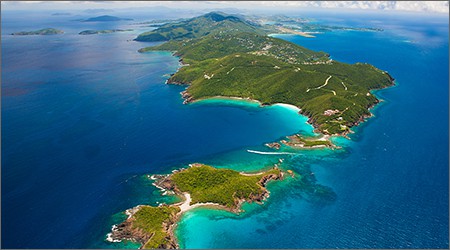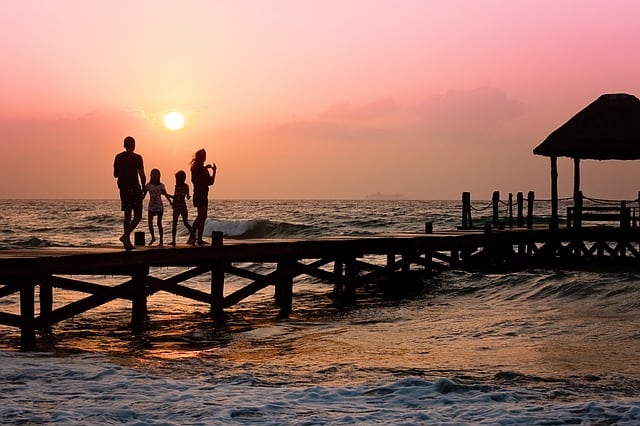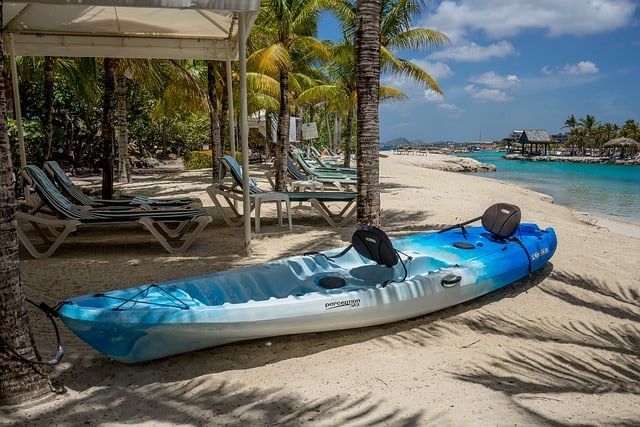The U.S. Virgin Islands are known as a hot spot for vacationers, but not because of excessive heat. Instead, the fairly mild weather that the USVI enjoys all year long gives travelers a chance to enjoy a more comfortable summer or warm up a bit during the winter. Still, you may be curious about what to expect in a tropical environment where humidity levels and average temperatures might be different from your hometown. From hurricanes to frizzy hair days, here’s all you need to know about the USVI weather and humidity patterns that occur throughout the year.
USVI Weather Overview
Most travelers can easily say that they enjoyed the weather in the USVI. The average temperatures between St. John, St. Thomas and St. Croix vary very little throughout the entire year. Not only does this give you your pick of islands to enjoy, but it also means that you’ll have more options for picking your preferred month or week to stay.
While the temperatures remain fairly steady, you will want to be prepared for precipitation that can occur at any point during your stay. High humidity is also common, which is easy to manage when you know what to expect.
7 Things to Expect From USVI Weather and Humidity
When you think about the Virgin Islands, you probably have a clear image of sunny beaches filled with opportunities to soak up the warmth as you explore one of the most beautiful natural environments in the world. If you picture a sunshine-filled paradise, then you already have the right idea about the weather.
But, things can sometimes veer slightly from the ideal scenario. Knowing about these seven things to expect regarding the USVI weather and humidity patterns helps you plan your stay and manage any surprises that the climate throws your way.
Look Forward to Warm USVI Temperatures Year-Round
As far as USVI temperature statistics go, the average in the summer is around 82 degrees Fahrenheit, and the area doesn’t get much cooler during the winter when the average temp is around 77 degrees Fahrenheit. If you come from a hot climate, such as Texas or Southern Arizona, then arriving to find that the temperature isn’t even in the 90s during the summer can be a huge relief.
If you come from a cooler climate where you feel as though the summertime average is a bit too high, then planning your trip for the winter can make it possible to enjoy a cooler trip. Either way, most people find that moderate temperature changes allow for more flexibility with trip planning.
Understand the General USVI Climate
The USVI falls within the tropical climate zone, which can lead to some different environmental changes than you might be accustomed to in your normal living environment. During certain parts of the year, the climate can be quite windy, and it’s common for the weather to change rather quickly when a storm rolls in. Some cloudiness is common on many days, and the humidity generally rises along with the heat.
Choosing the right place to stay in the USVI can help you adjust to the climate faster. For example, the Mare Blu Villa in St. John offers full air conditioning throughout the rooms that can help you cool off on a warm day when you’ve had lots of exciting adventures. Requesting a suite that faces a specific direction can also help you to enjoy more sunlight or have a patio that shields you from the wind as you dine al fresco.
Include the Hurricane Season In Your Planning
Statistically speaking, hurricanes are rare in the USVI, with approximately 16.55 years passing between major ones hitting the area. However, you may still want to note that the months of August through October are the prime hurricane season.
There are some advantages to traveling during the hurricane season, which can include finding lower rates on airfare and lodgings and fewer crowds at popular attractions. You may also be able to mitigate some of the risks of getting caught in a hurricane by staying in rentals on St. John that are at a higher elevation.
Take Simple Actions to Manage St. John Weather Changes
In addition to choosing the ideal luxury suite with features that include air conditioning, swimming pools and shaded areas to help you beat the heat, you can also use a few other strategies to adapt to changing weather conditions on the island.
For instance, the months of December 1st – May 2nd tend to have the lowest rates of precipitation, with March having the most dry days. That means you may want to plan your trip for then if you prefer a drier trip. If you arrive during the rainy months that occur out of that monthly range (May 2nd to December 1st), then make sure to pack a light rain jacket in your bag to help you stay dry if you get caught in a brief storm while exploring outdoors.
Embracing the humidity is also a part of life on the USVI. If you have long hair, then embracing the natural beach waves you achieve after swimming in the Caribbean is a fun way to fully immerse yourself in the island lifestyle. Or, you might try wearing braids to beat the heat and look like you belong in paradise when you snap a selfie.
Staying hydrated is also important no matter what time of year you visit the island. Adding a water bottle to your day bag helps your body to maintain its proper temperature, and you can even infuse your drink with a bit of fruit that gives every sip a tropical vibe.
St. Croix Weather and Sunscreen Laws
While St. Croix, St. Thomas, and St. John are all part of the US Virgin Islands and share a similar tropical climate, there are some differences in their weather patterns due to variations in their geographical locations and topography.
St. Croix, the largest of the US Virgin Islands, is situated the farthest to the south. It is more exposed to the trade winds and has a slightly drier climate compared to St. Thomas and St. John. The island experiences a mix of tropical savanna and semi-arid climate, with a longer dry season and less rainfall overall. This means that St. Croix may have more sunshine and lower average precipitation compared to the other two islands.
St. Thomas and St. John, being closer to the Atlantic Ocean, receive slightly more rainfall throughout the year. The wet season on these islands typically lasts from May to November, during which they experience higher humidity levels and a greater chance of encountering tropical showers and thunderstorms. The lush vegetation and vibrant flora are prominent features of these islands, thanks to the increased rainfall.
Follow the Laws Regarding Sun Protection in the USVI
St. Croix and the other Virgin Islands have enacted a law that prevents the use of certain sunscreens. Those containing oxybenzone, octinoxate and octocrylene have been outlawed to protect the marine life and corals that make their idyllic beaches so wonderful. Always check the label on sun protection products carefully to make sure that you don’t use one that contributes to the contamination of the USVI’s natural climate.
Wearing mineral sunscreen can still help you block out the sun’s rays while staying in compliance with local laws. Sunscreens containing zinc oxide and titanium dioxide are typically safe. Most visitors to the island also enjoy wearing wide-brimmed hats, rash guards and breezy sarongs to add further protection from the sun that enhances their fun.
Check the St. Thomas Weather Reports Each Day
During the late fall months, the islands tend to experience around eight to 13 rain events a month. While many rain showers are brief, they could interfere with our plans to enjoy dinner on the patio while overlooking the crystal blue waters. Or, you might prefer to go on your outdoor hiking adventure early on a day with expected high temperatures and humidity.
You’ll still want to do your research on the weather before you pack for your trip but try to take a moment to check the daily forecast during your stay. Keeping an eye on the sky isn’t hard when you’ve got amazing sunsets and sunrises in view. But, you might want to head inside when the winds pick up, or the clouds roll in, just in case it foretells a short tropical storm.
Know How the Virgin Islands Weather Impacts the High Season
Most years, the months of Christmas to Easter are viewed as the high season when more people are flocking to the islands than do the rest of the year.
The spring is the second busiest season for tourism. By this point in the year, the temperatures are warming up, and you might catch some rain. Still, you’ll find that most days are perfect for swimming, boating and surfing.
You might find that traveling during the slower season gives you more room to explore with fewer crowds. The majority of USVI excursions are still open almost year-round, which allows you to scuba dive, snorkel or even go skydiving as much as you want.
Pick Your Preferred Time to Visit the USVI
Now that you know a little more about the weather and climate in the USVI, you’re better prepared to make decisions about booking your trip. Whether you decide to visit during the winter or summer, remember that your choice of lodging plays a major role in your comfort. Once you have your perfect season, look for a suite with air conditioning, access to shaded cabanas and other amenities that all make your vacation more grand no matter what time of the year you arrive in this tropical paradise.

Kirsten Morgan is a passionate travel blogger based in the stunning St. John, U.S. Virgin Islands. With a deep love for island life and a knack for storytelling, Kirsten brings the vibrant culture, breathtaking landscapes, and hidden gems of the Caribbean to life through her captivating blogs.












